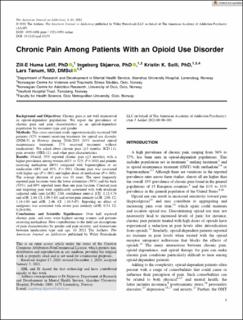| dc.contributor.author | Latif, Zill-E-Huma | |
| dc.contributor.author | Skjærvø, Ingeborg | |
| dc.contributor.author | Solli, Kristin Klemmetsby | |
| dc.contributor.author | Tanum, Lars Håkon Reiestad | |
| dc.date.accessioned | 2021-06-08T14:03:55Z | |
| dc.date.available | 2021-06-08T14:03:55Z | |
| dc.date.created | 2021-03-23T10:12:05Z | |
| dc.date.issued | 2021-03-19 | |
| dc.identifier.citation | American Journal on Addictions. 2021. | en_US |
| dc.identifier.issn | 1055-0496 | |
| dc.identifier.uri | https://hdl.handle.net/11250/2758547 | |
| dc.description.abstract | Background and objectives: Chronic pain is not well understood in opioid-dependent populations. We report the prevalence of chronic pain and pain characteristics in an opioid-dependent population by treatment type and gender. Methods: This cross-sectional study opportunistically recruited 569 patients (32% women) receiving treatment for opioid use disorder (DSM-5) in Norway during 2016-2018 (83% received opioid maintenance treatment, 17% received treatment without medication). We asked about chronic pain (≥3 months; ICD-11), pain severity (NRS-11), and other pain characteristics. Results: Overall, 55% reported chronic pain (≥3 months), with a higher prevalence among women (61% vs 52%, P = .041) and patients receiving methadone (66%) compared with buprenorphine or no medication (46% and 45%, P < .001). Chronic pain was associated with higher age (P < .001) and higher doses of methadone (P = .048). The average duration of pain was 11 years. The most frequently reported pain locations were the lower extremities (59%) and the back (54%), and 69% reported more than one pain location. Constant pain and migrating pain were significantly associated with both moderate (adjusted odds ratio [aOR]: 2.04, confidence interval [CI]: 1.12-3.74 and aOR: 2.44, CI: 1.09-5.43) and severe pain intensity (aOR: 2.08, CI: 1.14-3.80 and aOR: 2.46, CI: 1.10-5.47). Reporting no effect of analgesics was associated with severe pain intensity (aOR: 0.54, CI: 0.29-0.99). Conclusions and scientific significance: Over half reported chronic pain, and rates were highest among women and patients receiving methadone. New contributions to the field are descriptions of pain characteristics by gender and pain severity, and interactions between medication type and age. | en_US |
| dc.description.sponsorship | The study was funded by Akershus University Hospital. Patients were recruited in collaboration with Oslo University Hospital and Akershus University Hospital. | en_US |
| dc.language.iso | eng | en_US |
| dc.publisher | Wiley | en_US |
| dc.relation.ispartofseries | American Journal on Addictions; | |
| dc.rights | Navngivelse-Ikkekommersiell 4.0 Internasjonal | * |
| dc.rights.uri | http://creativecommons.org/licenses/by-nc/4.0/deed.no | * |
| dc.subject | Chronic pains | en_US |
| dc.subject | Patients | en_US |
| dc.subject | Opioid use disorders | en_US |
| dc.subject | Treatment types | en_US |
| dc.title | Chronic Pain Among Patients With an Opioid Use Disorder | en_US |
| dc.type | Peer reviewed | en_US |
| dc.type | Journal article | en_US |
| dc.description.version | publishedVersion | en_US |
| dc.rights.holder | © 2021 The Authors. | en_US |
| cristin.ispublished | true | |
| cristin.fulltext | original | |
| cristin.qualitycode | 1 | |
| dc.identifier.doi | https://doi.org/10.1111/ajad.13153 | |
| dc.identifier.cristin | 1900152 | |
| dc.source.journal | American Journal on Addictions | en_US |
| dc.source.pagenumber | 10 | en_US |

